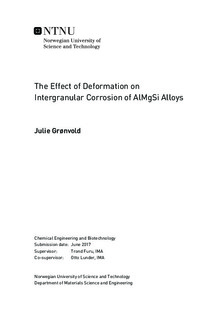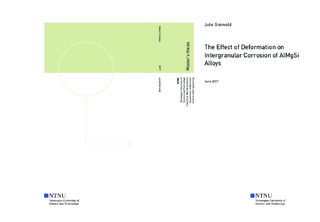| dc.description.abstract | The heat treatable AlMgSi alloys are regarded as medium strength materials with excellent corrosion properties. To achieve enhanced mechanical properties with the aim to expand the application areas, Cu may be added since this causes a refinement in precipitate dispersion and thereby increases strength, hardness and ductility. However, AlMgSi(Cu) alloys become sensitized to intergranular corrosion (IGC) during thermomechanical treatment, presumably due to precipitation of a continuous, Cu rich film along the grain boundaries which has been detected in several studies. Microgalvanic effects arise between the cathodic film and an adjacent, anodic, precipitate free zone. Cold deformation has been suggested as a measure to improve the IGC resistance of AlMgSi alloys, considering that deformation introduces dislocations, alters the microstructure in favorable ways and may change the precipitation process during ageing. The latter is of highly importance as the precipitates give rise to IGC. The objective of this work was to assess the effect of cold deformation on IGC susceptibility of AlMgSi alloys and obtain a better understanding of the corrosion mechanism in deformed materials.
Four different AlMgSi alloys, 6005.40, C28, 6016 A and 6016 B, were subjected to deformation by rolling or stretching either before or after final ageing treatment, that is either pre- or post-deformation. All alloys were aged to T6 temper, and a set of 6016 samples was also aged to simulate the paint bake cycle in the automotive industry. Vickers hardness measurements were conducted to evaluate the effect of deformation on hardness. Moreover, accelerated IGC testing according to ISO 11846 (method B) was performed on differently deformed and aged samples. Subsequently, the corroded microstructure of all samples was examined in light microscope to evaluate IGC resistance, and additionally, the uncorroded microstructure of 6005.40 was studied in scanning and transmission electron microscope to assess the effect of deformation on alloy microstructure and precipitate structure.
Results revealed that pre-deformation subsequent to solution heat treatment significantly improved IGC resistance, especially in Cu containing alloys, while maintaining good mechanical properties. It was shown by detailed precipitate examinations in transmission electron microscope that more Cu is incorporated into precipitates in pre-deformed materials compared to in undeformed materials. It is believed that this reduces the amount of Cu available for formation of the Cu rich film on the grain boundaries, thereby reducing IGC susceptibility. A transition to pitting-like corrosion was observed in the pre-deformed alloys. Pre-deformation after pre-baking of alloys for automotive applications proved to be detrimental for corrosion properties. However, it is believed that pre-deformation prior to pre-baking may be advantageous for achieving optimum paint bake response combined with good corrosion properties. The effect of post-deformation on mechanical and corrosion properties was ambiguous. Post-rolling somewhat improved the IGC resistance but did not increase the hardness, whereas post-stretching did not improve the IGC resistance but increased the hardness of the alloys. Further examinations are required to obtain knowledge of the corrosion mechanism in post-deformed materials. | |

